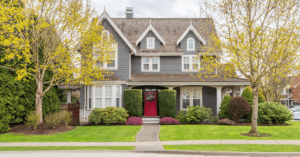Like many business sectors, the commercial real estate market has experienced uncertainty since the COVID-19 pandemic forced us all to stay home and rethink both short- and long-term investment goals, as well as our daily routines. Real estate capital markets froze in second-quarter 2020 with the beginning of shelter-in-place orders but were showing some signs of recovery by the third quarter.
According to Bloomberg, U.S. economic activity varies significantly across sectors. There is steady demand for manufacturing and housing, while restaurants and other service industries are stalling. Hotels and nonessential retail businesses also are suffering, although the expectation is that pent-up demand will prop up these businesses when widespread lockdowns begin to wane. The big question remains, when will this happen?
Facing uncertainty, many commercial mortgage lenders took a pause in March 2020. Some resumed closing new construction loans before the summer’s end. Some lenders — particularly those that target multifamily housing and other resilient asset types — were still expecting 2020 origination volumes to meet or exceed 2019 levels.
The COVID-19 pandemic and its economic fallout is not over, however, as cases were spiking this winter. Although consumer spending, employment and housing demand has strengthened, ongoing infection rates will likely continue to affect the recovery in varying ways by region and business sector throughout this period of correction and realignment. The good news is that an ongoing need for new housing will remain, especially in key markets with job and population growth. As such, for multifamily lenders, it is pretty much business as usual when taking into account credit, logic, data and economic realities.
The long view
It is appropriate to take a long-term view on the value of rental housing. Multifamily asset values, driven by rent growth, have steadily increased from the beginning of 2010 to the end of 2019, according to Freddie Mac and other data sources. Capitalization rates also decreased during this period. As of midyear 2020, Freddie Mac reported that apartment fundamentals had weakened with the coming of the pandemic and that new originations were likely to fall significantly in 2020. It added, however, that “the impact to multifamily demand will not be long-lived.”
This Freddie Mac data also illustrates the need for patience and stamina during recessions. If you made your equity bet in August 2007 when the commercial-property price index peaked, you would have had to wait until March 2013 to recover all of the lost equity value. The drop of the Freddie index to the bottom of the market at the end of 2009, however, showed that there was still sufficient value to cushion the blow from the Great Recession for a well-underwritten multifamily construction loan.
Short term, however, Freddie Mac’s data suggests that multifamily will not come out unscathed. The agency’s multifamily price index dropped slightly in second-quarter 2020 compared to the prior three months and was projected to drop in subsequent quarters. Sales volume also was expected to decline. Sellers are likely to hold off on disposing assets in a down market with declining rent collections and lower net operating incomes, as well as to avoid low-bid buyers trying to pick up a bargain from distressed sellers.
The summer 2020 Allen Matkins/UCLA Anderson Forecast — which gauges commercial real estate expectations — also was quite pessimistic and showed a drop in sentiment across all commercial real estate sectors. The participants predicted rent and occupancy declines for California multifamily properties through 2023 but believed that this would have little effect on current development activity.
Among the reasons why values remain strong, however, is the fact that a severe shortage of housing persists in several major cities. Freddie Mac estimated last year that 29 states have a housing-supply deficit, while the nationwide deficit is 3.3 million units of unmet demand. Multifamily construction lenders will follow demographic trends, ideally targeting the largest metro areas, urban infill locations, and coastal and gateway metros with population and job gains for their loan growth opportunities.
Demand for multifamily units — particularly those with an affordable component — will continue to outpace supply in the long run.
Strong demand
There has been strong demand for construction financing despite the pandemic, and many of these projects have an affordability component. To satisfy unmet demand, many communities have approved mixed-income projects. The increased number of market-rate units offset the cost of providing affordable housing. Developers find this trade-off particularly advantageous in some urban infill markets. With continuing housing shortages in numerous cities, these mixed-income projects can provide a measure of relief.
In one recent example, a multifamily construction loan closed for a project in the Koreatown neighborhood of Los Angeles. A portion of the units were set aside to be rented for well-below market rates to very low- and extremely low- income households. As a result, the developer was able to increase density and decrease lot-line setbacks to add more units on the site.
In another example, a construction loan closed for a project in a transit-oriented, working-class community in New Jersey. The local taxing authorities granted 30 years of real estate tax abatements in order to make the project feasible enough to support the costs of new construction. Many cities are able to use a combination of tax incentives, planning and building approvals, and housing and rent policies to drive new development, with the goal of meeting the housing needs of the local community.
In general, the outlook for multifamily seems to mirror good news from the U.S. Bureau of Labor Statistics. Unemployment, which skyrocketed from 4.4% to 14.7% between March and April of last year, had decreased to 6.9% by the end of October. The agency also reported that nearly 1.5 million jobs were created in August 2020.
Interestingly, according to the U.S. Census Bureau’s third-quarter 2020 report, more than 1.5 million business-formation applications were filed. Consumer and homebuilder confidence also are rising. In October 2020, the National Association of Home Builders/Wells Fargo Housing Market Index hit a new high, indicating an overwhelming number of builders viewed present and future market conditions for single-family homes as positive. Stock market indexes also recovered much of their losses associated with the pandemic.
Regardless of the shape of the economic recovery, however, demand for multifamily units — particularly those with an affordable component — will continue to outpace supply in the long run. The long-term trend should continue to be friendly. Prudent lenders with capital to invest are expected to continue approaching this market with an onward and upward view — be it a V-shaped or a swoosh-shaped recovery. ●
Author
-
Fabio Baum is managing director and senior underwriter at Parkview Financial, a direct private lender specializing in ground-up commercial and residential real estate financing. Baum focuses on underwriting, asset management and business development. He has expertise in equity investment, development, senior and mezzanine debt originations, dispositions and workouts.
View all posts




















































